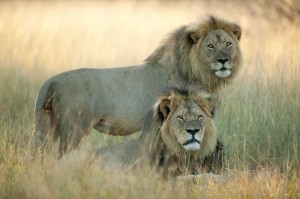
Image: Brent Stapelkamp
This is a story – a true story, and is as fascinating as it is factual. It demonstrates some of the interesting idiosyncrasies of lion life that have been documented by the Hwange Lion Research Team (HLR) through the use of radio tags and GPS collars.
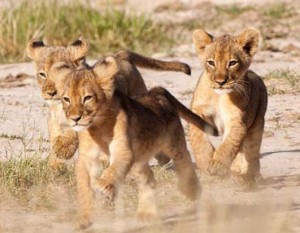
Image: scottyphotography.net
Although born at different times and with completely different lineage, Cecil and Jericho would have shared many common aspects in their very early weeks and months of life. Both would have been kept hidden to protect them for the first six or so weeks after birth, blind, helpless and totally dependent on their mothers for food and warmth. They would have been brought out of hiding and timorously introduced to the pride, would have known hunger, would have had to squabble, snarl and fight with other youngsters in the pride for the scraps of a kill. They would have known the freezing cold of Hwange winter nights and the breathless, blistering October daytime heat. They would have played and tussled with similar aged siblings, all the while learning vital skills needed in later years. They would have known the fright and confusion of dispersal males, driven from the pride at 3 or so years of age so as not to compete with the dominant male, nature’s way of dispersing the gene pool. They would have learned to become competent hunters in their own right in order to survive.
Cecil was first noticed by HLR in the dry winter season of 2008 with another lion thought to be his brother. The pair was first sighted at a pan in the southern area of Hwange called Mangisihole which when translated from the local dialect means “white man’s pan”. They were thus named Cecil and Leander after two early explorers of the land. Then estimated to be about 5 years old, Cecil and Leander were rather nervous, lacking confidence and seeking out hunting grounds to try and establish a pride of their own. In time they became braver and moved into a main study area of HLR, where Cecil was caught and collared for the first time. The Mangisihole Boys, as they became known, took over a pride at Ngweshla, and started a new generation of little lions.
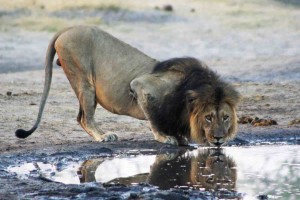
Image: Gary Cantle
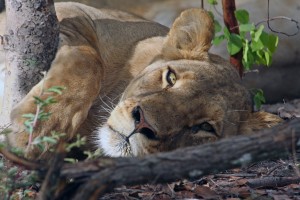
Image: Dave Dell
Jericho was born to the Guvalala Pride in June 2004 at Nyamandlovhu. His sire was a magnificent Hwange icon called Mpofu. Jericho was fortunate to have amongst his surviving siblings 2 brothers, one called Judah and the other Job who later became known as Scaredy Cat because he was uneasy around safari vehicles and always the first to slink away. These youngsters banded together at the time of dispersal, already showing signs of becoming fearsome aggressors. Shortly thereafter early in 2007, when the three were nearly full grown, increasing pressure from outside males seeking to take over Mpofu’s home range caused the aging patriarch to band together with his 3 impressive sons. Together they formed a mighty coalition of 4 males and were known as The Askaris, a word that originates from the Arabic language meaning “fighter”. They held a large territory, and were very successful.
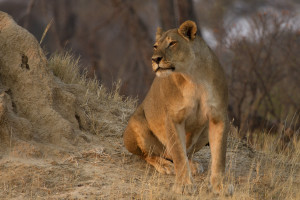
Image: Dave Dell
In June 2009, Cecil and Leander were seen to be moving into the territory of the Askaris, and Mpofu was found on his own – his boys were out philandering. There was a pride of young females known as the Junior Spice Pride nearby , some of whom were ready to mate, so Mpofu challenged the two intruders and a royal fight ensued. All 3 lions involved were grievously injured. Leander died within 10 days of the fight. Mpofu was mortally wounded, and with his right back leg broken, and bites to his spine, he lay at Ngweshla for 2 weeks, then hobbled on three legs to Broken Rifle, a beautiful pan on the Wilderness Concession, following a herd of buffalo. He somehow managed to kill a yearling buffalo, off which he fed for 5 days, and thereafter painfully limped to Kennedy 1 Pan some 10km (6 miles) away where he lay for weeks and withered away. When he died in Nov 2009, he was mourned by the researchers and parks staff who had come to know him, and by many members of the general public who were lucky enough to have seen him in his prime.
Cecil eventually recovered and survived, but was driven by his rivals, the 3 Askaris, down to an area near Linkwasha in the south east of the park. It was here that he flourished and reached his full grown, proud and regal magnificence with a massive frame and a beautiful black tinged mane. His pride grew to 22 in number, which is about as large as a pride gets in Hwange. He bore many scars, testament to fierce battles fought to extend his territory and drive out intruders, and he feared nothing and no one. But in 2012 Cecil eventually succumbed to the might of 2 new young males, and was squeezed out of his home range, and back towards Ngweshla.
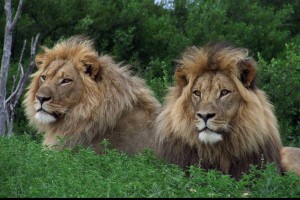
Image: Daffy Murumahoko
And so the tale turns back to the Askaris. They were capable of taking down buffalo with ease, and had been taught the art of killing young elephant by their legendary sire Mpofu, so they were sleek and well fed. But fate was not kind to them. Scaredy Cat was the victim of a trophy hunt in May 2010, and Judah, a beautiful male who would have equaled Cecil in size and stature suffered the same fate 6 months later. After a time, Jericho formed a new alliance with a male called Oliver and these two stayed together until Oliver too was hunted in July 2012. With Cecil on the run and Jericho in need of support once more, these 2 former mortal enemies came face to face early in 2013.
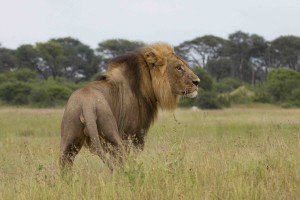
Image: Dave Dell
But in instead of carrying on the long, family feud, they seemingly realized that it would be better to forge an allegiance, a coalition to benefit them both. Cecil gained a territory and mating rites with Jericho’s prides, and Jericho gained a partner. Their combined presence was enough to hold off rivals seeking to invade their hunting grounds.
Very uneasy at first, theirs was a tetchy relationship, and they were – in the words of the researchers – “often beating each other up” each in a bid to gain dominance over the other. Nevertheless, they stuck together, formed a cohesive team and were seldom far apart. They held extensive territory, and their relaxed attitude around safari vehicles, impressive physical stature and the fact that they were often in areas frequented by visitors to Hwange, made them a star attraction. They headed 2 prides; one at Ngweshla called the Mak-Spice pride the other at Kennedy 1, known as the Somadada females. Strangely, there is a gentleman’s agreement between males of a coalition when it comes to mating rites. The rule is literally first come, first served. The male first on the scene to a female in oestris becomes her cohort, the other guy backs off and keeps his distance, and both will defend the cubs.
In a final twist of this tale, fate was to intervene again, and in July 2015, Cecil was prematurely butchered, the victim of that species of 2 legged creature deserving of the name “Homo Horribilis” coined by Bookey Peek * – the species that has caused havoc amongst these lions of Hwange. Baited to a kill, cruelly wounded with a compound bow, then tracked down and finally dispatched many hours later, Cecil met a painful, untimely and premature death, one that defies the laws of nature. Even Vincent, the faithful old camp attendant at Nweshla picnic site proclaimed with folded hands and eyes down cast “Ow ow ow – they have killem my lion”.
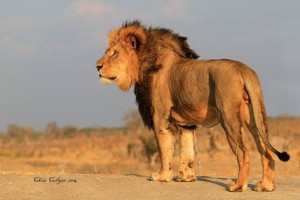
Image: Chris Collyer
Jericho has assumed sole responsibility for both prides, and for now is able to protect the 7 cubs that were born early this year. His roars echo out into the night, mournful, haunting, calling for his partner, waiting for a reply, and announcing his presence to other rival males.
Can Jericho hold on to his territory and his prides? Only time will tell. He is old for a lion, the life of any wild lion is always uncertain, and more often than not, he meets a bloody, violent and tragic end. Both Cecil and Jericho have already produced numerous progeny with wonderful genes, and these strong youngsters will doubtless carry on the legacy of their fathers and grandfathers. The new, wild born cubs will remain just that, wild and free, nothing less than they deserve, for few lovers of Hwange would willingly sanction their capture and confinement. The quest for survival of the fittest will continue in the endless circle of life.
With grateful thanks to the Hwange Lion Research team for accurate factual content.
*Full quote of Bookey Peek from her book Wild Honey, More Stories from an African Wildlife Sanctuary:
Homo Horribiis (sometimes jokingly referred to as Homo Sapiens)
– the killer ape
Like the house rat, this highly successful but destructive pest occurs in every country of the world. Bipedal, sparsely haired, omnivorous. Tends to gather in large, unsustainable numbers, mostly in an urban environment. Physically weak, but has well developed tool-using abilities. Our most aggressive mammal, it will attack without provocation, and is dangerous to all other species. Well known for its destruction of the environment and its tendency to kill large numbers of its own kind using highly sophisticated tools. Impossible to eradicate. Classified as Vermin.
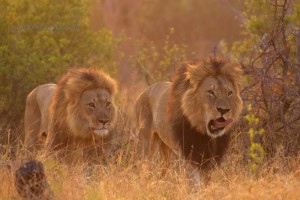
Image: scottyphotography.net
This article was written by Paula Dell.